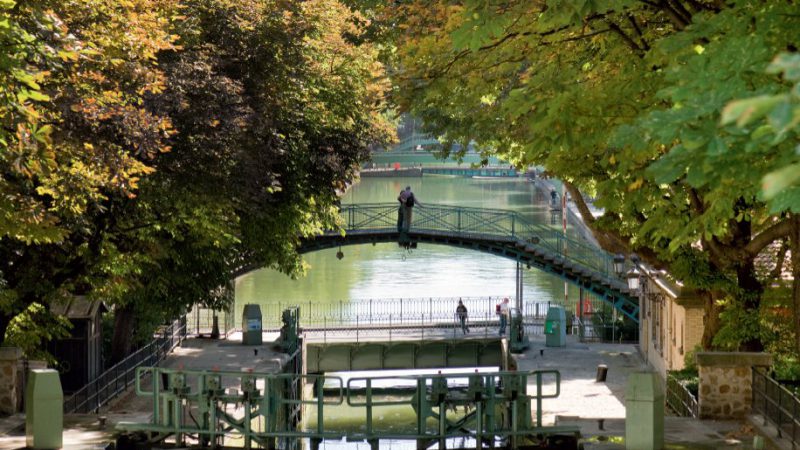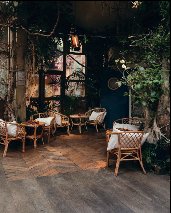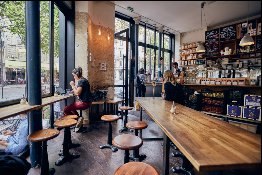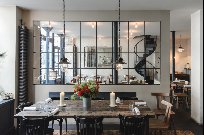Bohemian Rhapsody
Take a detour from Paris’s well-worn boulevards to these chic and characterful areas
September 30, 2019


The City of Light is justifiably regarded as one of the most beautiful capitals in the world, instantly recognizable for its Haussmann buildings and grand boulevards peppered with chic boutiques, brasseries and boulangeries. What most travelers miss, however, are the grittier arrondissements (districts) with arguably more character than the affluent picture-perfect center of the city.
Off the beaten track, these former working-class areas provide respite from the tourist-packed banks of the Seine. Becoming more gentrified by the day, the neighborhoods have recently acquired a reputation as “Bobo” (bourgeois bohemian), a product of their burgeoning café and arts scenes. With this, however, has come rising house prices and the danger that such quarters will become uniform – a source of anxiety for residents. Here’s our guide to three up-and-coming areas worth exploring if you have spare time on a trip.
Canal Saint-Martin
Located in the tenth arrondissement in eastern Paris, this canalside neighborhood is one of the city’s liveliest. Stretching nearly three miles, the canal links the Port de l’Arsenal with La Villette and was originally used as an artificial waterway to transport fresh water and goods to Paris in an attempt to reduce cholera and other epidemics.
The area has since swapped its practical purpose for a more social one, acting as the rendezvous point for picnics, apéro hour and Canauxrama cruises along the canal. It’s located within the Paris Respire zone, meaning cars are forbidden on Sundays and bank holidays from 10:00 AM until 6:00 PM, extending to 8:00 PM in summer.
Canal Saint-Martin isn’t typically Parisian, boasting more of a shabby-chic aesthetic than pristine grandeur – street art covers every corner, while protesters often use the canal as their (rather picturesque) route to the final staging area at Place de la République; it’s likely you’ll spot the gilets jaunes demonstrations against the government’s tax and social policies. Throw together London’s Shoreditch and a splash of Amsterdam’s quaint canal setting and you’ll get the idea. Repurposed warehouses have been given a new lease on life as stylish restaurants, bars and venues, while the canal’s banks and Venetian-style footbridges have been immortalized in films such as Amélie.
The area’s social reputation sadly made it a target of the November 2015 terror attacks. Outside diners were killed at Le Carillon and Le Petit Cambodge. Residents hit back, continuing to patronize the targeted spots with the the resilent slogan “Je suis en terrasse” (“I’m on the terrace.”) began trending on Twitter in the aftermath.
Within walking distance of both Gare du Nord and Gare de l’Est, Canal Saint-Martin has great transport links to the rest of the city and makes for a pleasant stroll if you have some time before your Eurostar departure. If you can’t quite switch off, you could visit one of the canal’s co-working cafés, Paris’s practical solution to small properties. Here, you either pay by the hour, or spend the same amount on food and coffee.
 Where to eat in canal saint-martin: La Marine is an all-day café and bistro with classic French cuisine at reasonable prices – a two-course lunch costs €18 ($20). Inside you’ll find art deco fixtures, while the heated terrace on the quayside is a prime spot for people-watching, facing the canal’s swing bridge. lamarinecanalsaintmartin.com
Where to eat in canal saint-martin: La Marine is an all-day café and bistro with classic French cuisine at reasonable prices – a two-course lunch costs €18 ($20). Inside you’ll find art deco fixtures, while the heated terrace on the quayside is a prime spot for people-watching, facing the canal’s swing bridge. lamarinecanalsaintmartin.com
Where to drink: Comptoir Général is the area’s most popular venue, a word-of-mouth spot set back from the canal – the only giveaway being the queues stretching down the quay on a Friday and Saturday night. Recently refurbished, the all-day Franco-African bar is an eclectic mix of vintage furnishings, vines crawling along distressed walls and an outdoor space flanked by hydrangeas. lecomptoirgeneral.com
What to see: Canalside arts center Point Ephémère is located in a former fire station and holds exhibitions, concerts and workshops. pointephemere.org
South Pigalle
Formerly the heart of the red-light district, South Pigalle in the ninth arrondissement has swapped its seedy past for a more high-end status, earning the name SoPi along the way – a nod to Manhattan’s SoHo. North of the city, it’s located just below Montmartre and in striking distance of Gare du Nord. Strictly speaking, it stretches from Blanche and Anvers to Notre-Dame-de-Lorette and Trinité – d’Estienne d’Orves.
The area has long been a stomping ground for writers, musicians and artists. Edith Piaf dedicated her song “Elle fréquentait la Rue Pigalle” to the area, while Henri Toulouse-Lautrec had a studio here and Josephine Baker chose to open her first nightclub in Pigalle. The Moulin Rouge remains its most prized possession, celebrating its 130th anniversary this year. But cast your eye beyond the building’s ruby-red windmill and you’ll get a glimpse of the new and improved SoPi.
Wander around and you’ll spy hip cocktail bars, organic cafés and retro hotels paying homage to its risqué past – the area’s most popular hideaway, a Polynesian tiki bar, goes by the name of Dirty Dick, while Hotel Amour is a stylish luxury revamp of a former brothel.
Other parts of the ninth arrondissement give no hint of the area’s gritty history – in particular the peaceful Nouvelle Athènes district. Recognizable for its neoclassical mansions and pretty squares, the area’s main draw is the Musée de la Vie Romantique, which displays works from the Romantic period, with a charming courtyard terrace ideal for après.
 Where to eat: Caillebotte is a small bistro inspired by the painter of the same name. Featuring an open kitchen, vintage posters and pale wooden furnishings, its sophisticated food offering is good value (two-course lunch €19 or $21). restaurant-caillebotte.com
Where to eat: Caillebotte is a small bistro inspired by the painter of the same name. Featuring an open kitchen, vintage posters and pale wooden furnishings, its sophisticated food offering is good value (two-course lunch €19 or $21). restaurant-caillebotte.com
Where to drink: KB Caféshop is one of the best examples of the city’s coffee scene, with baristas serving visitors on its bustling terrace, and freelancers tapping away inside. kbcafeshop.com
What to see: Rue des Martyrs is one of the capital’s oldest and most popular market streets. Sloping all the way from Sacré-Coeur to Notre-Dame-de-Lorette, it’s lined with 200 shops, cafés, delis and pâtisseries – don’t miss Sébastian Gaudard’s 19th-century façade and irresistible pastries at door number 22. sebastiengaudard.com/patisserie-des-martyrs
Bastille
To the east of Paris on the Rive Droite lies the historic Bastille area, easily accessible to business travelers thanks to its proximity to Gare de Lyon.
Despite the area’s notable history, the 11th arrondissement bears few scars of the revolutionary action that took place here. Perhaps not surprising given that the infamous “Storming of the Bastille” in 1789 destroyed the prison that once stood here. Place de la Bastille now marks the spot, with the towering Colonne de Juillet at its center commemorating the subsequent 1830 revolution (the basis of Victor Hugo’s Les Misérables); this year will see the opening of the lower part of the column to visitors.
The main square doubles as one of the city’s busiest roundabouts, characterized by mass demonstrations (a nod to its revolutionary past, and meeting point for the gilets jaunes) and heaving traffic. Currently occupied by roadworks, the square is set to welcome a continuous bike path to the Place de l’Etoile in December.
While the area has an impressive historical legacy, its appearance isn’t quite so dazzling. Bastille is hardly a pretty sight, its contemporary architecture and concrete design at odds with the city’s traditional Haussmann buildings. This is most apparent when comparing Paris’s two opera houses. Opéra Bastille, the larger of the two, is a postmodern building located at the intersection of the roundabout, paling in comparison with the majestic Palais Garnier in the ninth arrondissement.
Still, the Opéra Bastille has other star qualities, including its success in reaching a younger, more working-class crowd. This year marks the building’s 30th anniversary, and there are plans to build a new foyer, an 800-seat rehearsal and performance space, and workshop facilities, scheduled to be completed in 2023.
Bastille has also become the city’s urban playground, incorporating nature into its more brutalist design. The area’s elevated park, known both as the Promenade Plantée and Coulée Verte René-Dumont, was crafted from a disused 19th-century railway viaduct, beneath which lies a string of artist studios and boutiques. The inspiration for New York’s High Line, it is set to open a larger section next year.
 Where to eat: Septime is one of the city’s most in-demand restaurants, offering inventive cuisine with a waiting list worth signing up to. septime-charonne.fr
Where to eat: Septime is one of the city’s most in-demand restaurants, offering inventive cuisine with a waiting list worth signing up to. septime-charonne.fr
Where to drink: If there’s no room at the restaurant, head instead to Septime La Cave, its rustic bar offering small plates and wine pairings. septime-lacave.fr
What to see: The Marché d’Aligre, also called the Marché Beauvau, takes place six days a week (closed Mondays). Located between the Place de la Bastille and Place de la Nation, it comprises both a covered market and outdoor stalls and is a paradise for foodies and antique hunters.




